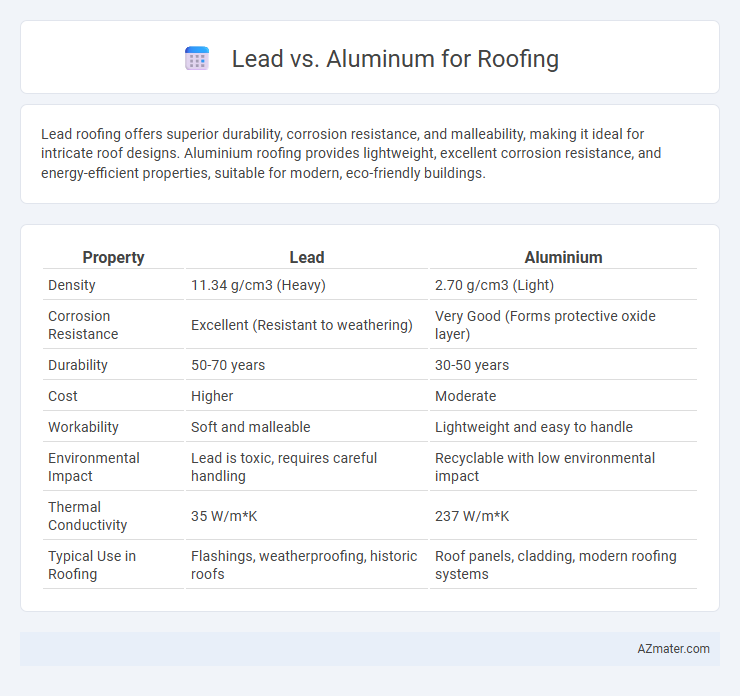Lead roofing offers superior durability, corrosion resistance, and malleability, making it ideal for intricate roof designs. Aluminium roofing provides lightweight, excellent corrosion resistance, and energy-efficient properties, suitable for modern, eco-friendly buildings.
Table of Comparison
| Property | Lead | Aluminium |
|---|---|---|
| Density | 11.34 g/cm3 (Heavy) | 2.70 g/cm3 (Light) |
| Corrosion Resistance | Excellent (Resistant to weathering) | Very Good (Forms protective oxide layer) |
| Durability | 50-70 years | 30-50 years |
| Cost | Higher | Moderate |
| Workability | Soft and malleable | Lightweight and easy to handle |
| Environmental Impact | Lead is toxic, requires careful handling | Recyclable with low environmental impact |
| Thermal Conductivity | 35 W/m*K | 237 W/m*K |
| Typical Use in Roofing | Flashings, weatherproofing, historic roofs | Roof panels, cladding, modern roofing systems |
Introduction to Lead and Aluminium Roofing
Lead roofing, known for its durability and malleability, has been used historically in construction for centuries, offering excellent weather resistance and a long lifespan of up to 100 years. Aluminium roofing provides a lightweight, corrosion-resistant alternative with a typical lifespan of 40 to 70 years, favored for its energy efficiency and ease of installation. Both materials serve distinct needs in roofing, with lead excelling in longevity and formability, while aluminium offers modern advantages like reduced weight and recyclability.
Material Properties: Lead vs Aluminium
Lead roofing offers superior malleability and excellent corrosion resistance, making it ideal for complex roof shapes and long-lasting protection in harsh weather conditions. Aluminium roofing is lightweight, highly resistant to rust, and provides excellent thermal reflectivity, helping to reduce heat absorption and improve energy efficiency. While lead is denser and heavier, aluminium's low density contributes to easier handling and lower structural load.
Durability and Longevity Comparison
Lead roofing offers exceptional durability with a lifespan exceeding 100 years due to its malleability and resistance to corrosion, making it ideal for historic or high-end buildings. Aluminium roofing typically lasts 40 to 60 years, valued for its lightweight properties and strong resistance to rust and oxidation, although it may be more prone to denting compared to lead. Both materials provide excellent weather resistance, but lead's superior longevity often justifies its higher initial cost in long-term roofing projects.
Cost Analysis: Lead Roofing vs Aluminium Roofing
Lead roofing typically involves higher initial material and installation costs due to its density and labor-intensive application, whereas aluminium roofing offers a more budget-friendly upfront investment with easier handling and faster installation. Over time, aluminium's lightweight and corrosion-resistant properties reduce maintenance expenses, whereas lead roofing, despite its durability and longevity, may incur higher upkeep costs to address potential oxidation and metal fatigue. The choice between lead and aluminium roofing ultimately hinges on balancing upfront expenditure against long-term maintenance and durability considerations specific to the building's structural and environmental context.
Environmental Impact and Sustainability
Lead roofing poses significant environmental risks due to its toxicity and challenges in recycling, which can lead to soil and water contamination. Aluminium offers a more sustainable alternative with its high recyclability rate, lightweight nature, and lower carbon footprint during production. Sustainable roofing decisions increasingly favor aluminium for reducing environmental impact and supporting circular economy principles.
Installation Process and Ease
Lead roofing offers exceptional malleability, allowing it to conform precisely to complex roof shapes with ease, which simplifies the installation process for detailed architectural designs. Aluminium roofing, being lighter and more rigid, requires fewer support structures and faster handling during installation, reducing labor time for large, flat surfaces. Both materials necessitate skilled labor, but aluminium's corrosion resistance and pre-fabricated panel options often streamline installation compared to traditional lead sheets.
Weather Resistance and Performance
Lead roofing offers exceptional weather resistance due to its high corrosion resistance and ability to expand and contract without cracking, ensuring long-term durability in harsh climates. Aluminium provides excellent rust resistance and is lightweight, though it may be more susceptible to denting and requires coatings to enhance UV and weather durability. Both materials perform well, but lead's self-healing properties and longevity often make it superior for prolonged exposure to extreme weather conditions.
Maintenance Requirements for Lead and Aluminium Roofs
Lead roofing requires minimal maintenance due to its durability and natural resistance to corrosion, typically only needing periodic inspections for potential cracks or surface damage. Aluminium roofs demand more frequent upkeep, including regular cleaning to prevent oxidation and checks for denting or paint degradation, especially in coastal or industrial areas. Both materials benefit from proper installation and timely repairs to maximize longevity and maintain their protective qualities.
Aesthetic Differences and Design Flexibility
Lead roofing offers a traditional, matte gray finish that naturally weathers to a soft patina, enhancing heritage architecture with its classic appearance. Aluminium provides a wider range of colors and finishes, including smooth, metallic, and textured surfaces, allowing for more modern and customizable design options. The malleability of lead supports intricate detailing and curves, while aluminium's lightweight properties enable diverse architectural styles and easier installation on complex roof shapes.
Choosing the Right Roofing Material for Your Project
Lead roofing offers exceptional durability and weather resistance, making it ideal for historical restorations or long-term projects. Aluminium roofing provides a lightweight, corrosion-resistant alternative with excellent energy efficiency, suitable for modern residential and commercial developments. Selecting the right roofing material depends on factors like project lifespan, environmental exposure, and budget constraints.

Infographic: Lead vs Aluminium for Roofing
 azmater.com
azmater.com